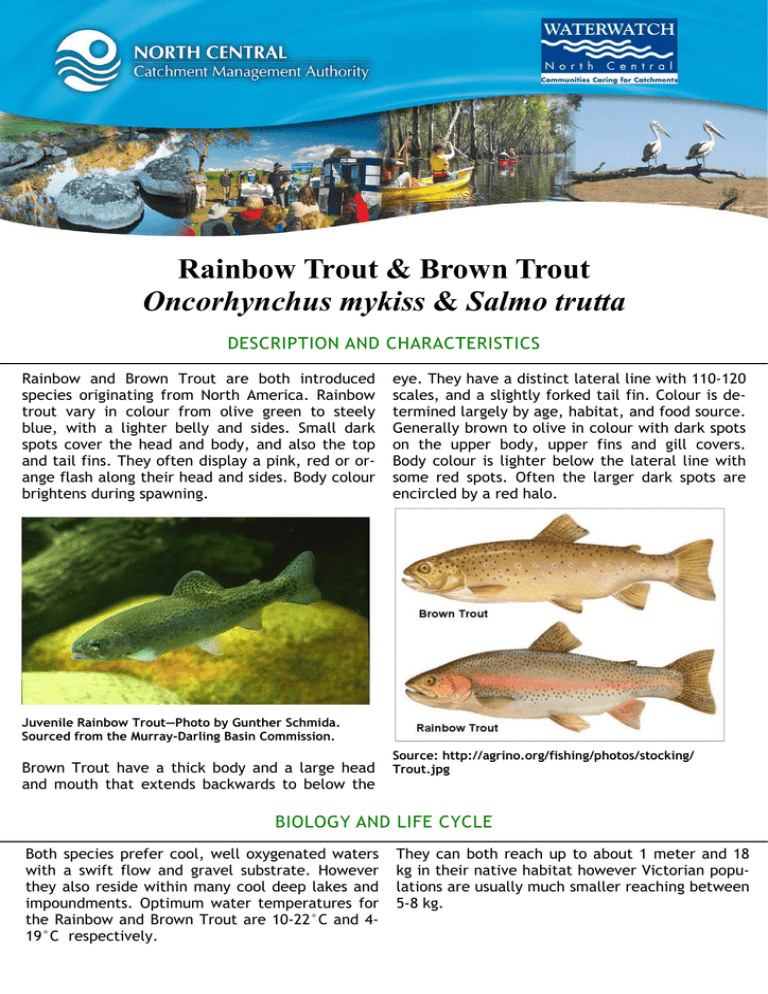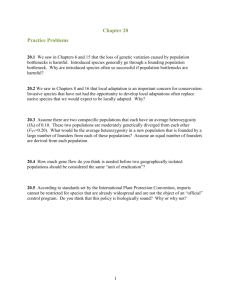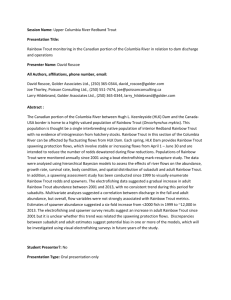Rainbow Trout & Brown Trout Oncorhynchus mykiss DESCRIPTION AND CHARACTERISTICS
advertisement

Rainbow Trout & Brown Trout Oncorhynchus mykiss & Salmo trutta DESCRIPTION AND CHARACTERISTICS Rainbow and Brown Trout are both introduced species originating from North America. Rainbow trout vary in colour from olive green to steely blue, with a lighter belly and sides. Small dark spots cover the head and body, and also the top and tail fins. They often display a pink, red or orange flash along their head and sides. Body colour brightens during spawning. eye. They have a distinct lateral line with 110-120 scales, and a slightly forked tail fin. Colour is determined largely by age, habitat, and food source. Generally brown to olive in colour with dark spots on the upper body, upper fins and gill covers. Body colour is lighter below the lateral line with some red spots. Often the larger dark spots are encircled by a red halo. Juvenile Rainbow Trout—Photo by Gunther Schmida. Sourced from the Murray-Darling Basin Commission. Brown Trout have a thick body and a large head and mouth that extends backwards to below the Source: http://agrino.org/fishing/photos/stocking/ Trout.jpg BIOLOGY AND LIFE CYCLE Both species prefer cool, well oxygenated waters with a swift flow and gravel substrate. However they also reside within many cool deep lakes and impoundments. Optimum water temperatures for the Rainbow and Brown Trout are 10-22°C and 419°C respectively. They can both reach up to about 1 meter and 18 kg in their native habitat however Victorian populations are usually much smaller reaching between 5-8 kg. BIOLOGY AND LIFE CYCLE ……….CONTINUED Rainbow Trout mature at about 3 years of age, with males developing a distinct upward hook on the lower jaw. Their breeding season runs from winter to early spring. About 1,500 eggs are produced per kilo of body weight and are laid in gravel substrate of flowing, highly oxygenated waters. Hatching takes between 3-12 weeks. their third year, during autumn and winter often following a flood. The female excavates depressions in the stream bed and lay about 1,600 eggs per kilo of body weight. After spawning the female covers the eggs with gravel. Eggs hatch after about 6 weeks and newly hatched fish have a prominent egg sac. Male Brown Trout become sexually mature at 2 years of age, indicated by a curved bottom jaw which develops into a hook. Spawning occurs in Rainbow and Brown Trout are both carnivorous, feeding on insects, crustaceans, molluscs, worms and small fish such as galaxids. ENVIRONMENTAL IMPACTS In Australia Rainbow and Brown Trout have both been implicated in the decline of many small native freshwater fish species, especially the galaxid fauna of Tasmania where four species are now critically endangered. Their negative impact is mostly due to predation on juveniles and competition with adults for food and space resources in limited supply. HISTORY OF INTRODUCTION Brown Trout were introduced to Australia via Tasmania in 1864 through the first successful importation of fertilized eggs after more than 20 years of efforts by various groups, while Rainbow Trout were introduced to Australia in 1894. DISPERSAL Both Rainbow and Brown Trout are widespread and common throughout many streams and lakes of Victoria. In many cases self-maintaining populations exist where suitable habitat exists. Some lake and reservoir populations are maintained by regular releases of hatchery-produced fish. LEGAL STATUS IN VICTORIA Despite the fact that both species of Trout are introduced they are not considered a pest species. The Victorian Department of Primary Industries considers Rainbow and Brown Trout as desirable introduced fish species because of their significant contribution to inland recreational fisheries. Their classification of “introduced” reflects their translocation to Australia and this category is noted in the Flora and Fauna Guarantee Act 1988 (introduced to Australia after 1788 AD). POSSIBLE CONTROL MEASURES Considering neither Rainbow or Brown Trout are listed as pest species there are no set control measures in place. Both species are known to predate on small forage fish species such as galaxids, consequently over population of these species in the wild will likely prove to be disadvantageous. Thus aquaculture farms using flow through systems need to ensure that measures to prevent the escape of Rainbow and Brown Trout, into natural systems containing small native forage fish, are adequate.







